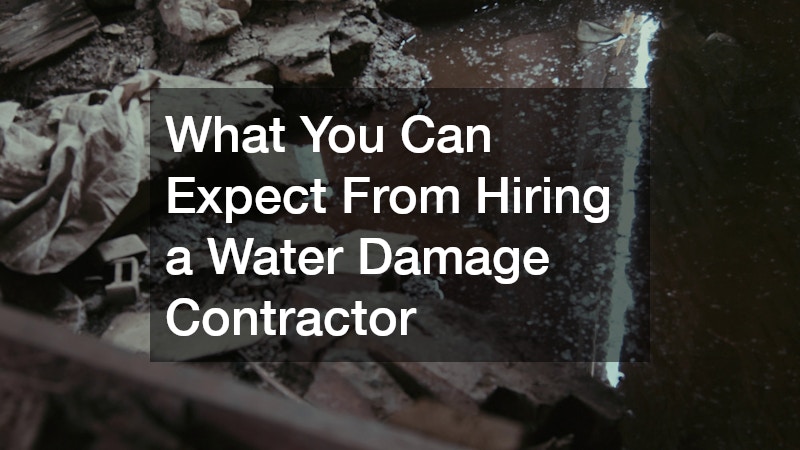This article explores the key aspects of hiring a water damage contractor, from initial evaluation to restoration and everything in between. We’ll answer frequently asked questions and provide insights into the process.
How Do I Choose the Right Water Damage Contractor?
Research and Recommendations
Choosing a water damage contractor should begin with thorough research and obtaining recommendations. Talk to friends, family, and neighbors who have previously used such services to gather reliable referrals.
Reading online reviews and checking with the Better Business Bureau can provide insights into contractor reliability and quality. Be sure to look for a contractor with a strong reputation in water damage restoration and verified customer satisfaction. Verifying that the contractor holds the necessary insurance to protect from potential liabilities is essential. This will give you the confidence that they are professional and legitimate in their field.
Certifications and Experience
When hiring a water damage contractor, checking for certifications and experience is crucial. Look for contractors certified by the Institute of Inspection, Cleaning and Restoration Certification (IICRC). Certification ensures that the contractor is trained in the latest water damage restoration techniques and adheres to industry standards. Experience is essential, as seasoned contractors are better equipped to handle unexpected complications. An experienced contractor will also be familiar with the insurance claim process, potentially aiding in faster claims; their experience handling various types of water damage assures their abilities.
What Services Does a Water Damage Contractor Provide?
Inspection and Assessment
The initial phase of water damage restoration involves a comprehensive inspection and assessment. Contractors use advanced equipment to detect moisture levels and identify the extent of the damage. The inspection process helps outline a clear plan of action that targets specific areas needing restoration. A thorough evaluation is vital in preventing long-term problems such as mold growth. Practical assessment sets the groundwork for successful restoration, making sure no hidden damages are left untreated. This proactive approach can save homeowners significant time and resources in the long run.
Restoration and Repair
Once the assessment is complete, the contractor completes the restoration and repair phase. Restoration involves removing excess water, drying affected areas, and cleaning and sanitizing to halt mold growth. Repair encompasses structural and cosmetic fixes, such as repairing drywall, flooring, and ceilings affected by water damage. Contractors with the right tools and skills can restore properties to their pre-damage condition efficiently. The thoroughness and experience of a contractor in this phase directly impact the success of the restoration. Professionals assure every step is meticulously executed, reducing the risk of future damage.
How Much Does It Cost to Hire a Water Damage Contractor?
Factors Influencing Cost
Several factors influence the cost of hiring a water damage contractor. The extent of the damage and the materials required for repair can significantly affect the overall cost. Location is another essential factor, as fees may vary depending on regional pricing and contractor availability. Emergency services, often needed in severe water damage situations, might incur additional charges. Understanding these factors helps in better financial planning and preparedness for potential water damage restoration costs. An open discussion with potential contractors about cost factors can provide clarity and alignment of expectations.
Understanding Estimates and Bids
When hiring a contractor, it’s essential to comprehend how estimates and bids are formulated. Estimates are approximate costs before project commencement, often based on initial inspection findings. Bids, however, are formal proposals outlining the project’s total price, including labor, materials, and other expenses. Requesting contractors to provide detailed bids is vital to avoid unexpected costs later. Negotiate transparent terms regarding the services covered in the bid. Assure the contract includes a timeline for completing the work, which can provide a structure for project completion.
What Should I Expect During the Water Damage Repair Process?
Timeline and Phases
The timeline for water damage repair involves multiple phases and is influenced by the severity of the damage. Initial assessment, water removal, and drying typically take several days. Subsequent phases, including repair and restoration, can vary extensively based on the extent of structural damage. A well-drafted timeline that the contractor provides minimizes disruptions and sets achievable project milestones. Each phase of the repair process is essential for comprehensive restoration. From the initial drying to final touch-ups, every detail plays a role in achieving a successful outcome.
Communication and Involvement
Effective communication between the homeowner and contractor is critical throughout the repair process. Regular updates and open channels help address concerns and align discussions around project modifications. Homeowner involvement ensures that personal preferences are considered, such as specific repair materials or design choices. It also helps in promptly addressing any unforeseen issues that may arise during restoration. Maintaining open lines of communication leads to a smoother repair experience. Homeowners can rest assured that their property is in trusted hands while being part of essential restoration decisions.


